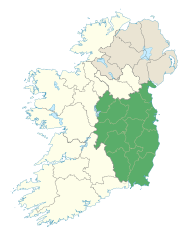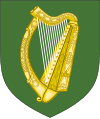Leinster facts for kids
Quick facts for kids
Leinster
Laighin
|
|||
|---|---|---|---|
|
|||
 |
|||
| State | Ireland | ||
| Counties | |||
| Area | |||
| • Total | 19,801 km2 (7,645 sq mi) | ||
| Area rank | 3rd | ||
| Population
(2022)
|
|||
| • Total | 2,870,354 | ||
| • Rank | 1st | ||
| • Density | 144.960/km2 (375.455/sq mi) | ||
| Time zone | UTC±0 (WET) | ||
| • Summer (DST) | UTC+1 (IST) | ||
| Eircode routing keys |
Beginning with A, C, D, K, N, R, W, Y (primarily)
|
||
| Telephone area codes | 01, 04x, 05x, 090 (primarily) | ||
| ISO 3166 code | IE-L | ||
| Patron Saint: Brigid a. Leinster contains the entirety of the Dublin constituency and parts of the South and Midlands–North-West constituencies; Leinster contains 44.4% of the population of the Midlands–North-West constituency and 32.3% of the population of the South constituency. | |||
Leinster (pronounced LEN-ster; Irish: Irish: Laighin or Cúige Laighean) is one of the four main regions, called provinces, in Ireland. It is located in the southeast part of the island.
Long ago, Leinster was made up of several ancient kingdoms, including Meath, Leinster, and Osraige. After the Norman invasion of Ireland in the 1100s, the old regions of Leinster and Meath slowly joined together. This formed the Leinster we know today. The traditional flag of Leinster shows a golden harp on a green background.
Leinster does not have an official role in local government. However, it is a recognized part of Ireland. It is listed with the code "IE-L" on international lists. With a population of over 2.8 million people in 2022, Leinster is the most populated province in Ireland.
Contents
History of Leinster
Early Beginnings
Before the year 1171, the Kingdom of Leinster was much smaller than the province is today. It usually did not include areas like Meath, Osraige, or the Viking cities of Wexford and Dublin.
The name Leinster comes from the word Laigin. This was the name of a large tribe that used to live in the area. The second part of the name, -ster, comes from either the Irish word tír or the Old Norse word staðr. Both of these words mean 'land' or 'territory'.
A legendary figure named Úgaine Mór (Hugony the Great) is said to have united the tribes of Leinster. He supposedly built a hill fort called Dún Ailinne in County Kildare. Later, around 175-185 AD, another legendary leader, Cathair Mor, re-established the kingdom of Laigin. The famous Irish hero, Fionn mac Cumhaill, is also said to have built a fort at the Hill of Allen.
In the 300s and 400s AD, after the Roman legions left Britain, people from Laigin settled in North Wales. They left their mark on the Llŷn Peninsula, which gets its name from Laigin.
By the 400s, new powerful families called the Uí Néill from Connacht took over parts of Westmeath, Meath, and Offaly from the Laigin people. The Uí Néill High Kings often tried to demand a large cattle-tax, called the Boroimhe Laighean, from the Laigin. This made them traditional enemies.
By the 700s, the rulers of Laigin had split into two main families. One was in the north, led by Murchad mac Brain. The other was in the south, led by Áed mac Colggen. After the last king from Kildare died in 1042, the leadership of Leinster went to the Uí Cheinnselaig family, who were based in what is now County Wexford. This southern family provided all the later Kings of Leinster.
Leinster in the Kingdom of Ireland
During the early 1600s, Leinster included the "English Pale". This was an area around Dublin that was directly controlled by the English. The other three provinces of Ireland had their own local governing systems. Over time, as more of Ireland came under English rule, the term "Leinster" began to include the wider area, not just the Pale.
The province of Leinster grew to include the old Kingdom of Mide. This covered much of today's Meath, Westmeath, and Longford. Other areas were added during the Tudor conquest of Ireland and later settlement schemes.
Some county borders also changed. County Louth officially moved from Ulster to Leinster in 1596. Parts of County Tipperary in Munster became part of Leinster in 1606. Even some parishes from Connacht were moved to Leinster in 1660. The last big change was the creation of County Wicklow between 1603 and 1606. This new county was formed from parts of northern County Carlow and southern County Dublin.
Geography and Counties
Leinster's Counties
Leinster is divided into twelve traditional counties. These are: Carlow, Dublin, Kildare, Kilkenny, Laois, Longford, Louth, Meath, Offaly, Westmeath, Wexford, and Wicklow.
Leinster has the most counties of any Irish province. However, it is the second smallest in terms of land area. With over 2.8 million people in 2022, it is the most populated province in Ireland. Dublin is the only official city in Leinster and is by far its largest settlement.
| County | Population (2022) |
Area |
|---|---|---|
| Carlow (Ceatharlach) | 61,968 | 897 km2 (346 sq mi) |
| Dublin (Baile Átha Cliath) | 1,458,154 | 922 km2 (356 sq mi) |
| Kildare (Cill Dara) | 247,774 | 1,695 km2 (654 sq mi) |
| Kilkenny (Cill Chainnigh) | 104,160 | 2,073 km2 (800 sq mi) |
| Laois (Laois) | 91,877 | 1,720 km2 (660 sq mi) |
| Longford (An Longfort) | 46,751 | 1,091 km2 (421 sq mi) |
| Louth (Lú) | 139,703 | 826 km2 (319 sq mi) |
| Meath (An Mhí) | 220,826 | 2,342 km2 (904 sq mi) |
| Offaly (Uíbh Fhailí) | 83,150 | 2,001 km2 (773 sq mi) |
| Westmeath (An Iarmhí) | 96,221 | 1,840 km2 (710 sq mi) |
| Wexford (Loch Garman) | 163,919 | 2,367 km2 (914 sq mi) |
| Wicklow (Cill Mhantáin) | 155,851 | 2,027 km2 (783 sq mi) |
| Total | 2,870,354 | 19,801 km2 (7,645 sq mi) |
Major Towns and Cities
Here are some of the larger settlements in Leinster, based on the 2016 census:
| # | Settlement | County | Municipal District Pop. | Settlement Pop. | Former Legal Town Pop. |
|---|---|---|---|---|---|
| 1 | Dublin City | County Dublin | 1,347,359 | 1,173,179 | 554,554 |
| 2 | Dundalk | County Louth | 55,806 | 39,004 | 32,520 |
| 3 | Kilkenny | County Kilkenny | 52,172 | 26,512 | 9,842 |
| 4 | Drogheda | County Louth | 44,052 | 40,956 | 31,785 |
| 5 | Swords | County Dublin | 42,738 | 39,248 | 36,924 |
| 6 | Bray | County Wicklow | 35,531 | 32,600 | 27,709 |
| 7 | Navan | County Meath | 34,931 | 30,173 | 30,097 |
| 8 | Carlow | County Carlow | 34,846 | 24,272 | 14,425 |
Culture and Sports
Languages Spoken
Like most of Ireland, English is the main language spoken in Leinster. However, there is also a group of people who speak Irish. In 2011, almost 19,000 people in Leinster spoke Irish daily outside of school. This included about 1,300 native speakers in a small Irish-speaking area called Ráth Chairn.
Many students in Leinster also learn Irish in school. In 2011, over 19,000 students attended Irish-language primary schools (Gaelscoils) and secondary schools (Gaelcholáistí) in the province. Most of these schools are in the Dublin area.
Sports and Organizations
Many sports and cultural groups in Ireland are organized by province. These include Leinster Rugby, the Leinster Cricket Union, Leinster Hockey Association, and Leinster GAA.
While Leinster GAA mainly includes teams from the traditional counties of Leinster, some teams from other provinces have also played in the Leinster Senior Hurling Championship. For example, teams from Galway, Kerry, Antrim, and even London have competed. Galway won the title in 2012. These teams can join based on how well they perform in the Christy Ring Cup.
See also
 In Spanish: Leinster para niños
In Spanish: Leinster para niños




